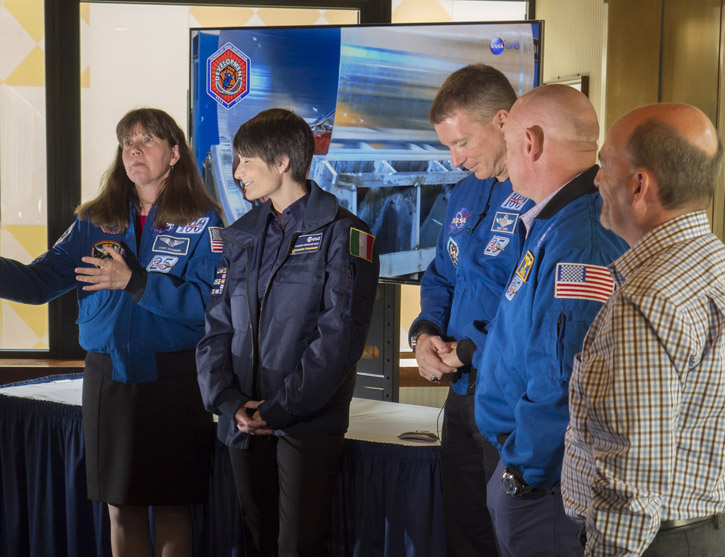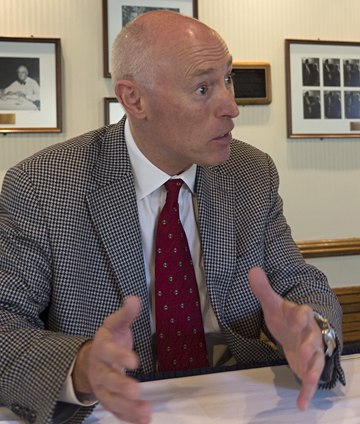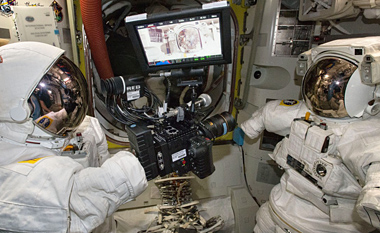NASA Kicks Off UHD Channel with ‘Out-of-this-World’ Content

Astronauts stand in front of a 4K display as they discuss NASA’s new UHD channel and content. From left to right are astronauts Cady Coleman, Samantha Cristoforetti, Terry Virts and Mark Kelly. Far right is Rodney Grubbs, a NASA imaging specialist.
WASHINGTON—One of the ongoing considerations regarding the sales growth of Ultra High Definition (also known as 4K) televisions has been the dearth of 4K programming. A recent announcement by NASA and its partner Harmonic will bring free 4K content down to earth, where it will be offered at no charge to cable systems and other programming providers.
Using satellite distribution provided by SES, the new 4K service will begin public service on Nov. 1. The video for the new service is being sourced from high-resolution images and video generated on the International Space Station, Hubble Space Telescope and other current NASA missions. Astronauts aboard the ISS have had 4K cameras for some time, and have acquired shots of both onboard experiments and the Earth.
Not only will much of the content be literally out of this world, it’s the goal of all parties to make it as affordable as possible—even free to viewers.
“No one is in this for a hard commercial benefit,” said Harmonic senior vice president Peter Alexander. “We think it will be great in terms of NASA, great in terms of the medium, and it just made sense to us.”

Peter Alexander, senior vice president and chief marketing officer for Harmonic, explains how the company’s encoders will be used on the new UHD service.
Making it work meant building new systems, and shifting assets on the ground and in space.
Get the TV Tech Newsletter
The professional video industry's #1 source for news, trends and product and tech information. Sign up below.
“NASA’s got a finite amount of transponder space to carry all of NASA TV,” Alexander said. “Until this project, it was all consumed with their HD and SD channels. We needed to re-compress what they were already doing to make room for the UHD channel.”
Existing content was re-encoded with a Harmonic Electra X3 processor using AVC compression, making room for UHD content that was compressed using HEVC encoding.
“We freed up enough for about 13 to 15 Mbps,” Alexander said. “It looks great. A lot of NASA’s imagery is fairly low motion, [which works well at this bit rate].”
HDR VIDEO
NASA and Harmonic will conduct experiments with high dynamic range video, to better understand the encoding necessary to carry HDR 4K images. In particular, Alexander said that they plan to use Hybrid Log Gamma processing for HDR content, which he said was compatible with both standard and HDR displays.
Harmonic gets raw 4K video from NASA, including shots taken aboard the ISS. The company’s goal is to process the video with Hybrid Log Gamma, and release that as the 4K feed. That way, viewers with non-HDR sets will receive viewable 4K, while viewers with HDR capability will see the greater dynamic range. All this will fit in the 13-15 Mbps available transponder slot.
NASA’s 4K channel will be available to retailers to show off their 4K displays. It will also be available to viewers who use providers such as Comcast, Cox, Time-Warner, Verizon and others. Alexander said that Armstrong is one cable TV operator that currently plans to carry NASA’s 4K channel. The costs to the cable operator will be an IRD on the receiving end and to find space in its channel lineup for the channel. Of course, viewers will need set-top boxes capable of decoding the HEVC-encoded data stream.
Much of the 4K content now available to NASA is shot by NASA itself, including the astronauts on the ISS. Available to them on the ISS are a couple of Red cinematography cameras, and they get used often.
TELL THE STORY

Astronauts use a Red Epic Dragon camera aboard the ISS.
At a recent NASA press event in Washington, astronauts said that one of their roles is to “tell the story” of what they do in space, to make their work more accessible to those of us on the ground.
“It’s really important,” said NASA astronaut Terry Virts. “Without this, only five or six people would enjoy [the perspective from space].”
Virts shot video on the ISS with a Red Epic Dragon 6K camera, which was then used by NASA to show what life was like in space, as well as get gorgeous views of the Earth below. Virts, a colonel in the U.S. Air Force, studied aeronautical science in school but quickly warmed up to shooting with the Dragon camera.
“I love it—it’s a great camera,” Virts said at the NASA press event. “The Red Dragon has a touch-screen monitor that’s really nice.”
Although not a videographer, Virts and his fellow astronauts received video training on the ground so that they better understand how to get great shots in space.
“We had classes and learned about lighting and sound,” he said. “Sound is something we overlooked a lot.”
As for what makes a good video clip from space, Virts said that it is often the most simple and mundane things, but they can look dramatically different on the ISS than they do on the ground.
“One of my favorite shots I took in space was sleeping,” he said. “I got a picture of Samantha [Christoforetti, an astronaut from the European Space Agency] sleeping. It was kind of staged and we had it planned, but just to see a person sleeping in space and totally serendipitously an object would float by right as I was filming, and it makes you feel like ‘Wow, that’s what it’s like to sleep in space.’”
Virts mentioned an experiment that Cristoforetti started, where objects (in this case, M&Ms) were placed in a clear plastic ball. After a short time, the candies all settled to one side of the ball instead of floating as expected. Virts repeated the experiment on camera in other modules on the ISS, discovering that the M&Ms would settle in different directions in different modules, due to what is now believed to be a “gravity gradient.”
“Hopefully physics teachers can use the video as an example to explain this gravity gradient,” Virts said.
Other NASA content for the new 4K service will include documentaries, launch videos (often with shots taken from unusual angles) and the range of programming now available on the agency’s cable channel. Long-recorded footage can’t miraculously be converted to 4K, of course, but ongoing projects will increasingly be available in in UHD resolution.
Bob Kovacs is the former Technology Editor for TV Tech and editor of Government Video. He is a long-time video engineer and writer, who now works as a video producer for a government agency. In 2020, Kovacs won several awards as the editor and co-producer of the short film "Rendezvous."

